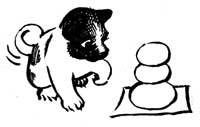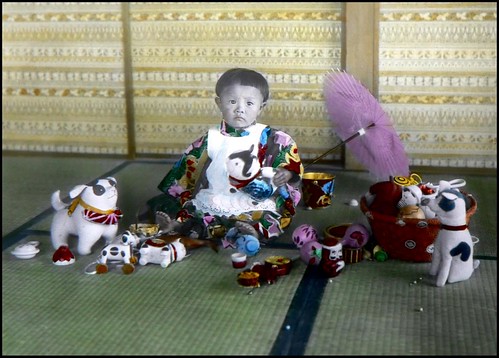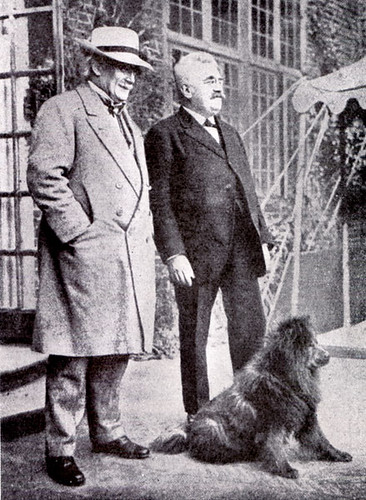
One of
Goldenbird's most popular characters (if not THE most popular ever) is
Mochi, a little (though she seems to be growing at an alarming speed) puppy of shady Japanese origin.
Mochi is a 10-week-old Akita-ken (秋田犬), precocious and cheerful but also very sensitive. The Akita breed has a complicated history; back in the 1910-20's, it didn't exist in the shape as we know it today. Mochi's black-and-white colouring is evidence of that. Today, the Japanese breed standards exclude white dogs with black markings (pinto). This was not the case 100 years ago. There was no breed standard - but there was a growing notion of the Akita dog as an uniquely Japanese breed that deserved to be preserved. In 1931, the Akita-ken was declared a natural monument. The first official breed standard wasn't published until 1934.

The large hunting dogs of the Akita prefecture had attracted the attention of the Meiji emperor. In a famous and widely spread photograph, two Akita dogs are presented to the emperor. Both are black with white markings or vice-versa. This colouring was later judged to be un-Japanese, as a result of interbreeding with large, imported dogs from Europe and probably also China and Korea. Interestingly,
recent studies on the dog genome have shown that the Akita, in spite of being a modern "reconstruction", retains ancient genetic material which makes it unique among breeds.
The group of 14 "ancient" breeds defined by this study includes mainly East Asian dogs such as the Shiba, the Chow, the Shar-Pei and the Siberian husky, which makes me believe that the "foreign" heritage in the Akita could be East Asian rather than European. Indeed,
Tatsuo Kimura mentions in his "History of the Akita Dog" that as early as "A.D. 358, black pinto dogs resembling Japanese dogs of today are said to have come from Korea". "Ancient breeds" are human constructions - the natural state of dogs is to have puppies with any available and fit mate. The back-breeding of the 20th century Akita to an idealized primitive state is an impossible project. The result is certainly an attractive dog, but it is not any more authentic than the discarded bloodlines.
Old woodcuts from the Edo period and the Meiji era show that Japanese artists found pinto dogs attractive and worthy of depiction. These puppies are not necessarily Akitas; there are several smaller spitz-type breeds in more southern parts of Japan, such as the Shiba-ken and the Shikoku-ken, which might have been available as models.

Puppies by
Hokusai Katsushika
A Winter Scene by
Chikanobu (1890)

Playful Puppies by
Kawanabe Kyosai (1831-1889)

Two Puppies Playing by
Koga Iijima (1900)

Yoshioka Ichimisai’s daughter Sono (from the series
Twenty-four Paragons of Filial Piety of Our Country) by Kuniyoshi (1842-1843) (See the
Kuniyoshi Project)

Mother, Child and Pups by
Utamaro (1753-1806)

Puppy Playing With Geta (EDIT: at closer inspection it appears to be a
zori) by
Seiho Takeuchi (1906)

Puppies and Snail by
Sekka Kamisaka (1909)
These last puppies represent two of the standard colours for Akita-ken today. The third permitted colour is the impressive
brindle. The pinto pattern is permitted in the American Akita standard. This breed descends from dogs that were imported to North America (and Europe) before the implementation of the modern Japanese standards.
For most people in Japan today, a pinto Akita looks unfamiliar. The black-and-white Akita lives on as a small lucky papier mache figurine:
Inuhariko (犬張り子), a gift for expectant mothers and newborn babies. I like to think of Mochi as Mayann's own live
inuhariko.
Sources:
Northland Akitas: Akita Learning Center (Lots and lots of interesting information)
The New York Times - ScienceKyototraditions.comThe Daily Yomiuri/Yomiuri ShimbunArt galleries:
Arts and Designs of JapanJapan Print GalleryThe Kuniyoshi Project***








































